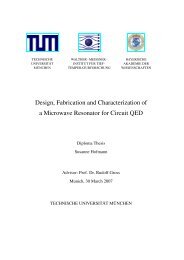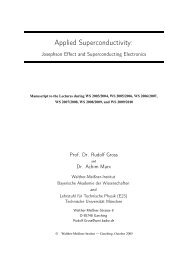SL_Introduction.pdf - Walther Meißner Institut
SL_Introduction.pdf - Walther Meißner Institut
SL_Introduction.pdf - Walther Meißner Institut
Create successful ePaper yourself
Turn your PDF publications into a flip-book with our unique Google optimized e-Paper software.
R. Gross © <strong>Walther</strong>-Meißner-<strong>Institut</strong> (2001 - 2012)Intro - 1SuperconductivityandLow TemperaturePhysics ILecture NotesWinter Semester 2012/2013R. Gross© <strong>Walther</strong>-Meißner-<strong>Institut</strong>
R. Gross © <strong>Walther</strong>-Meißner-<strong>Institut</strong> (2001 - 2012)Intro - 2Superconductivity
R. Gross © <strong>Walther</strong>-Meißner-<strong>Institut</strong> (2001 - 2012)Intro - 3
R. Gross © <strong>Walther</strong>-Meißner-<strong>Institut</strong> (2001 - 2012)General Remarks on the Courses to the FieldSuperconductivity and Low Temperature PhysicsIntro - 41. Superconductivity and Low Temperature Physics I + II Part I (WS 2012/2013): Foundations of SuperconductivityThis lecture Part II (SS 2013): Foundations of Low Temperature Physics and Techniques2. Applied Superconductivity I + II moved to SS 2013, 4 hrs lecture + 2 hrs exercises Josephson-Effect, Superconducting Electronics, quantum circuits (QIP)3. Theory of superconductivity for experimentalists on demand (contact D. Einzel, WMI) - Graduiertenkolleg4. Seminars (WS 2012/2013, WMI seminar room) Advances in Solid State Physics (TUE 10:15-11:30) Superconducting Quantum Circuits (TUE 16:00-17:15)Further information:http://www.wmi.badw.de/teaching announcement of lectures downloads of lecture notes, handouts… seminar topics
R. Gross © <strong>Walther</strong>-Meißner-<strong>Institut</strong> (2001 - 2012)Intro - 6Nobel Prizes in Physics related to low temperature physicsyear name discovery1913 Heike Kamerlingh Onnes "For his investigations on the properties of matter at low temperatures which led,inter alia, to the production of liquid helium"1972 John Bardeen, Leon Neil Cooper andRobert Schrieffer"for their jointly developed theory of superconductivity, usually called the BCStheory"1973 Brian David Josephson "for his theoretical predictions of the properties of a supercurrent through a tunnelbarrier, in particular those phenomena which are generally known as the Josephsoneffect"1978 Pjotr Kapiza "for his basic inventions and discoveries in the area of low-temperature physics"1985 Klaus von Klitzing "for the discovery of the quantized Hall effect"1987 Johannes Georg Bednorz undKarl Alex Müller1996 David M. Lee, Douglas D. Osheroff undRobert C. Richardson1997 Steven Chu, Claude Cohen-Tannoudjiand William D. Phillips1998 Robert B. Laughlin, Horst LudwigStörmer and Daniel Chee Tsui2001 Eric A. Cornell, Wolfgang Ketterle andCarl E. Wieman2003 Alexei Abrikosov, Witali Ginsburg andAnthony James Leggett"for their important break-through in the discovery of superconductivity in ceramicmaterials""for their discovery of superfluidity in helium-3""for development of methods to cool and trap atoms with laser light" See Lasercooling."for their discovery of a new form of quantum fluid with fractionally chargedexcitations". See Quantum Hall effect."for the achievement of Bose-Einstein condensation in dilute gases of alkali atoms,and for early fundamental studies of the properties of the condensates""for pioneering contributions to the theory of superconductors and superfluids"
R. Gross © <strong>Walther</strong>-Meißner-<strong>Institut</strong> (2001 - 2012)Contents of LectureSuperconductivity and Low Temperature Physics I<strong>Introduction</strong>1. Basic Properties of Superconductors2. Phenomenological Models of Superconductivity :- London equations- macroscopic quantum model- Ginzburg-Landau theory3. Thermodynamics4. Microscopic (BCS) theory5. Flux pinning and critical currents6. High Temperature Superconductivity7. ApplicationsSuperconductivity and Low Temperature Physics II1. Bose-Einstein condensation2. Superfluid Helium ( 4 He and 3 He)3. Quantum Interference Effects in Mesoscopic Conductors4. Low Temperature Techniques(generation and measurement of low temperatures)Intro - 7
R. Gross © <strong>Walther</strong>-Meißner-<strong>Institut</strong> (2001 - 2012)Literature• Werner Buckel, Reinhold Kleiner, Supraleitung – Grundlagen undAnwendungen, VCH-Verlag, Weinheim (2004).• M. Tinkham, <strong>Introduction</strong> to Superconductivity,McGraw-Hill, New York (1975).• J.F. Annett, Superconductivity, Superfluids and Condensates (2004)• V.V. Schmidt, The Physics of Superconductors (1997)• J. R. Waldram, Superconductivity of Metals and Cuprates (1996)• D.R. Tilley and J. Tilley, Superfluidity and Superconductivity• P. Komarek, Hochstromanwendungen der Supraleitung (1995)• T. P. Sheathen, <strong>Introduction</strong> to High T c Superconductivity (1994)• M. Acquarone, High Temperature Superconductivity (1996)• WMI Lecture Noteshttp://www.wmi.badw.de/teaching/Lecturenotes/index.htmle.g. chapter 13 of lecture on solid-state physicsIntro - 8
R. Gross © <strong>Walther</strong>-Meißner-<strong>Institut</strong> (2001 - 2012)LiteratureRudolf Gross, Achim MarxFestkörperphysik2012. XVIII, 982 S., gebundenISBN 978-3-486-71294-0€ 49,80 inkl. MwSt., versandkostenfreiIntro - 9
R. Gross © <strong>Walther</strong>-Meißner-<strong>Institut</strong> (2001 - 2012)Intro - 10<strong>Introduction</strong>
R. Gross © <strong>Walther</strong>-Meißner-<strong>Institut</strong> (2001 - 2012)temperature (K)nuclearmagnetismelectronicmagnetismsuperconductivitylow temperature researchTemperature Scale10 910 810 710 6center of hottest starscenter of the sun, nuclear energiessame amount of new physicson every decade of log T scale10 510 410 310 210 110 0electronic energies, chemical bondingsurface of sun, highest boiling temperaturesorganic lifeliquid airliquid 4 Heuniverse10 -110 -210 -3superfluid 3 He10 -410 -510 -610 -7lowest temperatures of condensed matterlowest temperature in nuclear spin system achieved by adiabatic demagnetizationof Rhodium nuclei: ≈ 100 pKIntro - 11
R. Gross © <strong>Walther</strong>-Meißner-<strong>Institut</strong> (2001 - 2012)Generation of Low Temperatureslow temperaturesultra-low temperaturesparamagnetic refrigerationnuclear demagnetizationYearIntro - 12
R. Gross © <strong>Walther</strong>-Meißner-<strong>Institut</strong> (2001 - 2012)Low Temperature Technology1868 offer of chair at thePolytechnische Schule München (now TUM)1873 development of cooling machine allowingthe temperature stabilization in beerbrewing21. 6. 1879 foundation of „Gesellschaft für Linde’sEismaschinen AG“ together with twobeer brewers and three other co-founders1892 - 1910 re-establishment of professorship12.5.1903patent application:„Lindesches Gegenstromverfahren“liquefaction of oxygen(-182°C = 90 K)Carl Paul Gottfried von Linde* 11. Juni 1842 in Berndorf, Oberfranken† 16. November 1934 in MunichIntro - 13
R. Gross © <strong>Walther</strong>-Meißner-<strong>Institut</strong> (2001 - 2012)Low Temperature TechnologyIntro - 141930 Linde AG uses the first cooling turbines for the generation of lowtemperaturesturbines have higher efficiency and therefore are used today inall larger liquefaction machinese.g. He liquefier at the <strong>Walther</strong>-Meißner-<strong>Institut</strong>1947 first commercial He liquefier (design by engineer Collins,therefore denoted as „Collins“ machine)Arthur D. Little Inc. (today CTI)1966 Hall et al. and Neganov et al. develop 3 He/ 4 He dilutionrefrigerators, generation of temperatures down to 2 mK
R. Gross © <strong>Walther</strong>-Meißner-<strong>Institut</strong> (2001 - 2012)Discovery of Superconductivity (1911)Heike Kammerlingh Onnes (1853-1926)Widerstand (W)Universität Leiden (1911)Hg
R. Gross © <strong>Walther</strong>-Meißner-<strong>Institut</strong> (2001 - 2012)Discovery of Superconductivity (1911)Kammerlingh Onnes and Techniker FlimKammerlingh Onnes and van der WaalsIntro - 17
R. Gross © <strong>Walther</strong>-Meißner-<strong>Institut</strong> (2001 - 2012)Discovery of the Meißner-Ochsenfeld Effect (1933)perfect diamagnetismRobert Ochsenfeld(1901 – 1993)W. Meißner, R. Ochsenfeld,Ein neuer Effekt bei Eintritt der Supraleitfähigkeit,Naturwissenschaften 21, 787 (1933).<strong>Walther</strong> Meißner(1882 – 1974)Intro - 18
R. Gross © <strong>Walther</strong>-Meißner-<strong>Institut</strong> (2001 - 2012)<strong>Walther</strong> Meißner (1882 – 1974)Discovery of the Meißner-Ochsenfeld Effect (1933)BBsuperconductorT > T CT < T Csuperconductors perfectly expel magnetic fieldBin c B 01exideal diamagnetism, c = – 1(c = magneticsusceptibilitychoice of name for perfect diamagnetism:Meißner-Ochsenfeld EffectIntro - 19
R. Gross © <strong>Walther</strong>-Meißner-<strong>Institut</strong> (2001 - 2012)<strong>Walther</strong> Meißner (1882 – 1974)1913 – 1934building and heading of low temperaturelaboratory at the Physikalisch-Technischen-Reichsanstalt, liquefaction of H 2 (20K)7.3.1925 first liquefaction of He in Germany(4.2 K, 200 ml), 3 rd system world-widebesides Leiden and Toronto1933 discovery of perfect diamagnetism ofsuperconductors together with Ochsenfeld Meißner-Ochsenfeld Effect1934 offer of chair at theTechnische Hochschule München (now TUM)1946 – 1950president of the Bayerischen Akademie derWissenschaften1946 foundation of the commission for LowTemperature Research <strong>Walther</strong>-Meißner-<strong>Institut</strong><strong>Walther</strong> Meißner* 16. Dezember 1882 in Berlin† 15. November 1974 in MunichIntro - 20
R. Gross © <strong>Walther</strong>-Meißner-<strong>Institut</strong> (2001 - 2012)Intro - 22Applications of Superconductivity
R. Gross © <strong>Walther</strong>-Meißner-<strong>Institut</strong> (2001 - 2012)Superconducting Wires, Tapes, and CablesIntro - 23Superconducting Wires:NbTi, Nb 3 Sn in Cu-matrixHTS tapes
R. Gross © <strong>Walther</strong>-Meißner-<strong>Institut</strong> (2001 - 2012)Superconducting WiresIntro - 24
R. Gross © <strong>Walther</strong>-Meißner-<strong>Institut</strong> (2001 - 2012)Intro - 26Superconducting HTS cablesSumitomoSchutzhülleStahlrohrelektrische IsolationHochtemperatur-SupraleiterLN 2LN 2
R. Gross © <strong>Walther</strong>-Meißner-<strong>Institut</strong> (2001 - 2012)Fabrication of superconducting tapesIntro - 27
R. Gross © <strong>Walther</strong>-Meißner-<strong>Institut</strong> (2001 - 2012)Intro - 28
R. Gross © <strong>Walther</strong>-Meißner-<strong>Institut</strong> (2001 - 2012)Applications of superconductivityIntro - 29• power applications (transport and storagecurrent limiterof energyenergy storage(2 MJ)
R. Gross © <strong>Walther</strong>-Meißner-<strong>Institut</strong> (2001 - 2012)Fault Current LimitersIntro - 30(Source: Physik Journal 6, 2011)
R. Gross © <strong>Walther</strong>-Meißner-<strong>Institut</strong> (2001 - 2012)Generators(Source: Physik Journal 6, 2011)Intro - 31
R. Gross © <strong>Walther</strong>-Meißner-<strong>Institut</strong> (2001 - 2012)Superconducting Magnets(Source: Physik Journal 6, 2011)Intro - 32
R. Gross © <strong>Walther</strong>-Meißner-<strong>Institut</strong> (2001 - 2012)Applications of superconductivityIntro - 33• transportation systems and trafficMLX01Jap. Yamanashi MAGLEV-System(42.8 km long test track between Sakaigawaand Akiyama, Japan)maximum velocity:581 km/h (02. 12. 2003)
R. Gross © <strong>Walther</strong>-Meißner-<strong>Institut</strong> (2001 - 2012)Applications of superconductivityIntro - 34• superconducting magnetshigh energy physicsMRI systemsfusion
R. Gross © <strong>Walther</strong>-Meißner-<strong>Institut</strong> (2001 - 2012)MRI SystemsIntro - 35
R. Gross © <strong>Walther</strong>-Meißner-<strong>Institut</strong> (2001 - 2012)Applications of superconductivityIntro - 36• information and communication systems
R. Gross © <strong>Walther</strong>-Meißner-<strong>Institut</strong> (2001 - 2012)Applications of superconductivityIntro - 38• sensors and detectorsmicrowave receiversQuantum interferencedetectors
R. Gross © <strong>Walther</strong>-Meißner-<strong>Institut</strong> (2001 - 2012)Biomagnetismenvironmental noise signalsearth magnetic fieldurban noisecar @ 50mscrew driver @ 2mtransistor,IC chip @ 2msingle transistor@ 1mcar @ 2kmB (Tesla)10 -410 -510 -610 -710 -810 -910 -1010 -1110 -1210 -1310 -1410 -15biomagnetic signalslung particlehuman heartmusclesfoetal hearthuman eyehuman brain (a)human brain(stimulated)foetal brain1 mmSuperconductingQuantum InterferenceDetector (SQUID)sensitivity:a few fT/√HzPTB BerlinIntro - 40
R. Gross © <strong>Walther</strong>-Meißner-<strong>Institut</strong> (2001 - 2012)Intro - 41Biomagnetism
R. Gross © <strong>Walther</strong>-Meißner-<strong>Institut</strong> (2001 - 2012)Intro - 42Josephson ComputerK. K. Likharev, SUNY Stony Brook
R. Gross © <strong>Walther</strong>-Meißner-<strong>Institut</strong> (2001 - 2012)From mechanical to quantum mechanical IPIntro - 43superconducting Qubit20 µmphysicsIntel dual-core 45 nm(2007)WMItechnologyEnigma (1940)vacuum tubesENIAC (1946)first transistor (1947)Bardeen, Brattain, & Shockley
R. Gross © <strong>Walther</strong>-Meißner-<strong>Institut</strong> (2001 - 2012)Intro - 44Superconducting Quantum Circuitscoplanar waveguideresonator1.25 GHzQ > 10 5Flux Qubithybrid ringS 23 = - 3 dBS 31 = - 50 dB
R. Gross © <strong>Walther</strong>-Meißner-<strong>Institut</strong> (2001 - 2012)Quantum Information ProcessingCollaborative Research Center 631:Solid State Quantum Information Processingspokesman: R. GrossIntro - 45
R. Gross © <strong>Walther</strong>-Meißner-<strong>Institut</strong> (2001 - 2012)NanosystemsIntro - 46Cluster of ExcellenceNanosystems Initiative Munich (NIM)spokesman: J. Feldmanncoordinator of RA I -Quantum Nanophysics: R. Gross
















